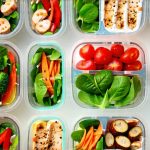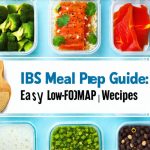Afternoon nausea and indigestion following a seemingly harmless packed lunch are surprisingly common experiences. Many people assume digestive discomfort stems from overeating or stress, but often the culprit lies within the combination of foods chosen, their preparation, and even how they’re packaged for portability. A meticulously planned lunch can quickly turn into an afternoon misery if not thoughtfully constructed with sensitivity to individual digestive tolerances. It’s about more than just avoiding obviously ‘bad’ foods; it’s understanding how different elements interact within the body during digestion and creating a balanced, easily-processed meal that supports sustained energy rather than causing distress.
The goal isn’t restriction or deprivation – quite the opposite! It’s about empowerment through knowledge. Learning to identify potential triggers, opting for gentler alternatives, and prioritizing mindful food choices can transform lunchtime from a source of anxiety into a nourishing and enjoyable part of the day. This applies whether you’re packing for yourself, your children, or someone else with digestive sensitivities. Ultimately, creating nausea-free packed lunches is about understanding your body’s unique needs and tailoring meals accordingly to promote optimal well-being throughout the afternoon.
Decoding Digestive Triggers in Packed Lunches
Many common lunch staples can contribute to discomfort if you’re prone to indigestion or nausea. Highly processed foods, for example, often contain additives, artificial flavors, and excessive amounts of sugar or unhealthy fats that are difficult to digest. These ingredients can disrupt gut motility – the natural muscle contractions that move food through your digestive system – leading to bloating, gas, and even nausea. Similarly, foods high in acidity (like citrus fruits or tomato-based sauces) can exacerbate symptoms for individuals with acid reflux or sensitive stomachs. But it’s rarely about eliminating entire food groups; instead, it’s about moderation and thoughtful pairings. You might want to learn more about foods that trigger bloating for those with sensitive systems.
Beyond specific ingredients, preparation methods play a significant role. Fried foods are notoriously difficult to digest due to their high fat content. Even seemingly healthy options like avocados can cause issues if consumed in large quantities or combined with other hard-to-digest items. Consider the temperature of your lunch too – extremely cold or very hot food can sometimes trigger digestive upset. Furthermore, rapid eating without proper chewing makes the digestive system work harder and increases the likelihood of discomfort.
Finally, packaging matters! Using plastic containers that leach chemicals when heated or exposed to certain foods is something to be mindful of. Opting for glass, stainless steel, or BPA-free plastic alternatives can minimize potential irritants. Even the way food is layered within the container impacts digestion – ensuring a balance of textures and preventing overly dense combinations makes for smoother processing. The key takeaway here is that it’s not always what you eat, but how you eat and how it’s prepared that contributes to digestive well-being. Understanding daily habits that disrupt digestion can also provide helpful insight.
Gentle Food Swaps & Smart Combinations
Making small substitutions can drastically reduce the likelihood of triggering nausea or indigestion. For instance:
- Replace sugary sodas with water infused with cucumber and mint.
- Swap white bread for whole-grain options, which are easier on the stomach due to their fiber content (but introduce gradually).
- Trade heavily processed snacks like chips for a handful of almonds or walnuts – healthy fats in moderation can be beneficial.
- Substitute fried chicken for grilled or baked poultry.
Smart food combinations are also crucial. Avoid pairing large amounts of protein with high-fat foods, as this slows digestion and increases the risk of discomfort. Instead, focus on balanced pairings like lean protein with complex carbohydrates and vegetables. For example: a small portion of grilled chicken breast with quinoa and steamed broccoli is much gentler on the digestive system than a fried chicken sandwich with potato chips. Prioritizing easily digestible foods and avoiding overly rich or heavy combinations are fundamental to nausea-free lunches. Tips for creating balanced meals can help you navigate this process.
The Role of Fiber & Hydration
Fiber is essential for healthy digestion, but too much at once can actually exacerbate symptoms like bloating and gas. When introducing more fiber into your diet (or a child’s), do so gradually. Start with small portions of high-fiber foods like oats, berries, or cooked vegetables and monitor how the body responds. Combining fiber with adequate hydration is also paramount. Water helps move fiber through the digestive tract efficiently, preventing constipation and reducing discomfort.
Dehydration can significantly contribute to nausea, especially when combined with a heavy meal. Ensure your packed lunch includes a bottle of water (or a reusable water container) and encourage regular sipping throughout the afternoon. Herbal teas – like ginger or peppermint – can also be soothing for sensitive stomachs, but avoid caffeinated beverages as they can sometimes worsen digestive issues. A well-hydrated body is better equipped to process food effectively, minimizing the risk of nausea and indigestion. Effective ways to manage these symptoms can also be helpful.
Mindful Eating & Portion Control
Even with the most carefully curated lunch, mindful eating habits are essential. Encourage slow, deliberate chewing – this breaks down food more efficiently and reduces strain on the digestive system. Avoid rushing through meals or multitasking while eating, as this can lead to overeating and impaired digestion. Portion control is also key. Smaller, more frequent ‘meals’ (or snacks) throughout the afternoon are often easier to digest than one large lunch.
Consider breaking up your packed lunch into several smaller containers – a portion of protein in one, carbohydrates in another, and vegetables/fruits in a third. This encourages mindful consumption and prevents overwhelming the digestive system with a single large quantity of food. Remember, listening to your body’s signals is paramount. If you start feeling uncomfortable during or after lunch, stop eating and rest. Don’t push through discomfort; it’s a sign that something isn’t agreeing with you. You might also consider tracking food triggers to better understand your individual sensitivities, and how to manage them. Finally, don’t forget about the impact of evening snacks on digestive health!


















